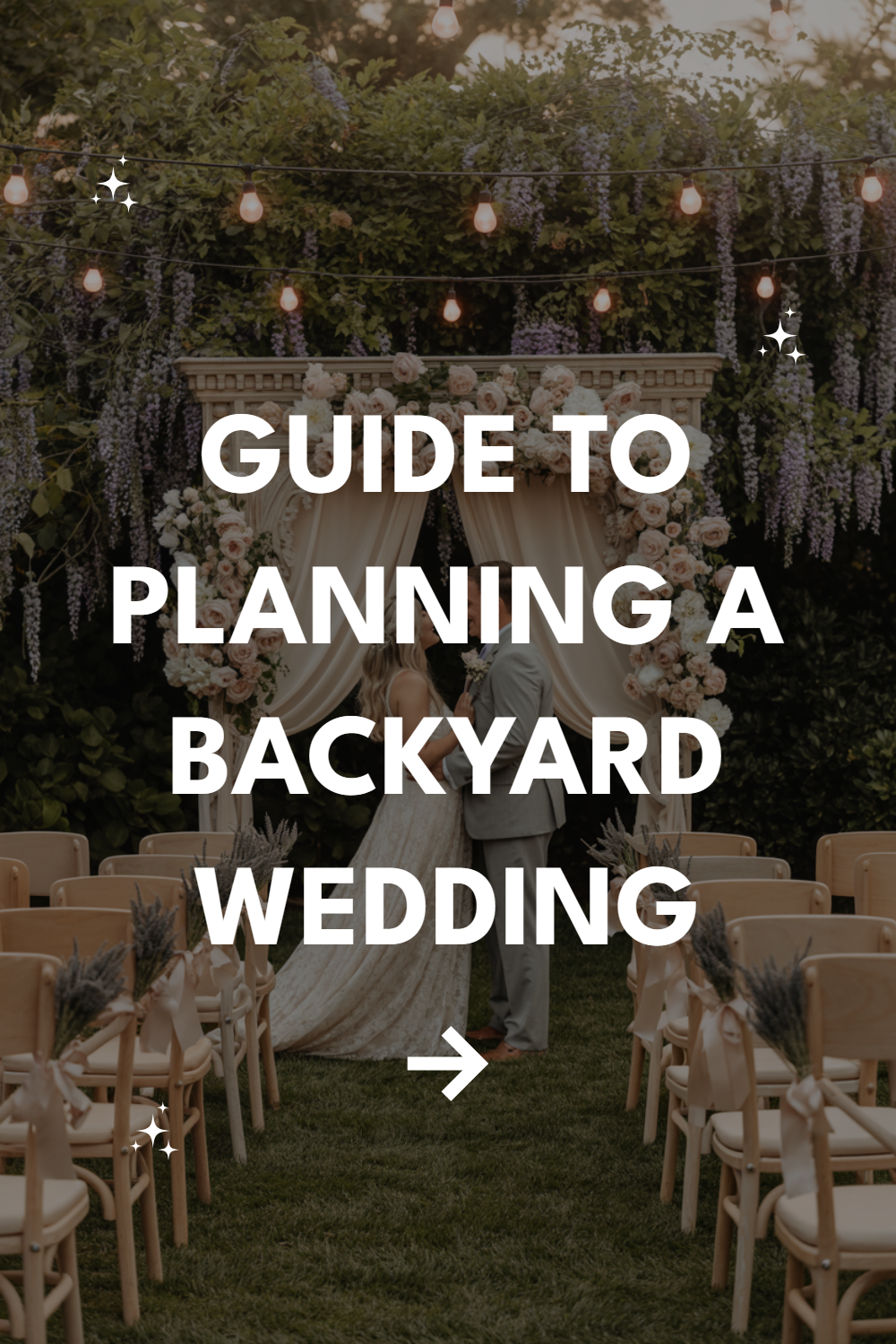Planning a backyard wedding feels romantic until you realize your aunt’s prize-winning roses might not photograph well next to Uncle Bob’s rusty grill.
But here’s the truth: backyard weddings can be absolutely magical when you know what you’re doing.
The key is treating your outdoor space like the venue it’s about to become, not just the place where you barbecue on Sundays.
Setting the Foundation
Evaluating Your Space Honestly
Walk outside right now and look at your backyard with fresh eyes. Forget the sentimental attachment to that crooked fence or the “charming” patch of dead grass. Your guests will see what’s actually there, not what you remember from childhood summers.
Consider the practical elements first: how many people can comfortably fit, where will they park, and what happens if it rains?
A backyard that feels spacious for family gatherings can feel cramped when you add a dance floor, catering station, and great-aunt Martha’s wheelchair.
Weather Contingency Planning
Mother Nature doesn’t care about your Pinterest board. Have a backup plan that doesn’t involve cramming forty guests into your living room. Tent rentals might seem expensive until you’re watching your centerpieces blow away in a surprise windstorm.
Check historical weather patterns for your wedding date, not just the forecast. If you’re getting married in April and it’s rained every April for the past five years, plan accordingly.
Legal and Logistical Essentials
Permits and Neighborhood Relations
Your city might have opinions about your backyard bash. Many municipalities require permits for gatherings over a certain size, especially if you’re serving alcohol or hiring vendors with large equipment.
Talk to your neighbors before sending invitations. A heads-up about potential parking overflow and music timing goes a long way toward maintaining peaceful relationships.
Trust me, you don’t want Mrs. Henderson calling noise complaints during your first dance.
Insurance Considerations
Your homeowner’s insurance might not cover wedding-related incidents. Check your policy and consider event insurance – it’s surprisingly affordable and covers everything from vendor no-shows to weather cancellations.
Liability matters more in your backyard than at traditional venues. If someone trips over your garden hose or gets food poisoning from the caterer, guess whose property it happened on?
Infrastructure and Utilities
Power and Lighting Requirements
That single outdoor outlet won’t power a wedding. Calculate your electrical needs: DJ equipment, catering warmers, lighting, and photo booth props all need juice. Professional electricians can run temporary power lines, but book them early.
Lighting transforms any space from backyard to wedding venue. String lights work for ambiance, but you’ll need proper illumination for dining and dancing. Solar options exist, but don’t rely on them for critical lighting needs.
Water and Restroom Access
One guest bathroom won’t cut it for a wedding reception. Portable restroom rentals have come a long way – modern units look nothing like construction site porta-potties. Budget for at least one unit per 25 guests.
Consider water access for catering needs, cleanup, and emergencies. Garden hoses work for some vendors, but others need proper kitchen-style setups.
Design and Decor Strategy
Working with Natural Elements
Your backyard already has character – work with it instead of against it. Mature trees provide natural canopy and photo backdrops. Existing landscaping can anchor your color scheme better than fighting it with clashing florals.
Seasonal considerations affect more than weather. Spring weddings showcase blooming gardens, while fall celebrations benefit from natural color palettes. Summer requires shade planning, and winter needs warming elements.
Creating Defined Spaces
Guests need clear direction about where to go and what to do. Create distinct areas for ceremony, cocktails, dining, and dancing. Even simple rope barriers or potted plants can define spaces without feeling restrictive.
Flow matters as much as individual areas. Guests should move naturally from ceremony to reception without confusion or bottlenecks. Map out foot traffic patterns before finalizing your layout.
Vendor Coordination and Logistics
Access and Setup Considerations
Your caterer needs to get equipment from their truck to your backyard. If that involves narrow side gates, stairs, or delicate landscaping, discuss solutions beforehand. Some vendors charge extra for difficult access situations.
Setup and breakdown timing affects your entire wedding day schedule. Vendors might need access hours before guests arrive and time after everyone leaves. Coordinate these schedules to avoid conflicts.
Delivery and Parking Logistics
Rental deliveries happen on tight schedules. Tables, chairs, tents, and linens often arrive the day before, requiring secure storage and protection from weather. Plan staging areas that don’t interfere with your pre-wedding preparations.
Guest parking presents unique challenges in residential areas. Survey available street parking and consider shuttle services from nearby lots if necessary. Parking attendants help maximize space and prevent neighbor disputes.
Budget Considerations and Hidden Costs
| Expense Category | Typical Cost Range | Often Overlooked Items |
|---|---|---|
| Tent Rental | $300-$2,000 | Flooring, sidewalls, heating/cooling |
| Power/Utilities | $200-$800 | Generator fuel, extension cords, outlets |
| Restroom Facilities | $150-$400 | Hand sanitizer, attendant, cleaning |
| Landscaping Prep | $100-$1,000 | Lawn repair, bush trimming, cleanup |
Rental Equipment Essentials
Everything you take for granted at traditional venues becomes a rental expense. Tables, chairs, linens, dinnerware, glassware, and serving pieces add up quickly. Get itemized quotes and compare package deals versus individual rentals.
Delivery fees, setup charges, and pickup costs often surprise couples. Some companies include these services, others charge separately. Factor in damage waivers – they’re usually worth the peace of mind.
Unexpected Expenses
Backyard weddings generate unique costs that traditional venues handle internally. Ground protection for heavy equipment, additional security deposits, and last-minute weather accommodations can blow budgets.
Cleanup costs more than anticipated. Professional cleaning services familiar with event aftermath charge differently than regular house cleaners. Factor in landscape restoration if vendors damage grass or gardens.
Timeline and Day-of Coordination
Setup Schedule Management
Vendor arrival times need careful orchestration. Tent companies come first, followed by flooring, then tables and chairs.
Caterers need kitchen access, florists need staging areas, and musicians need sound checks. Create a detailed timeline and share it with everyone involved.
Personal preparation becomes complicated when your getting-ready space is also vendor central station. Designate off-limits areas or arrange alternative preparation locations for the wedding party.
Managing Guest Experience
Guests need clear directions, parking guidance, and facilities information. Create simple signage that matches your wedding aesthetic while providing practical information. Consider appointing family members as informal hosts to help with questions.
Weather monitoring becomes crucial on wedding day. Have contingency plans ready to implement and someone designated to make weather-related decisions. Guests appreciate proactive communication about changes.
Making Magic Happen
Backyard weddings require more hands-on coordination than traditional venues, but they offer intimacy and personalization impossible elsewhere. Your guests will remember dancing under your oak tree long after they’ve forgotten generic ballroom receptions.
The secret lies in thorough planning and realistic expectations. Embrace the charming imperfections while ensuring basic comfort and safety.
Your backyard wedding can be every bit as elegant and memorable as any fancy venue – just with better stories to tell afterward.


